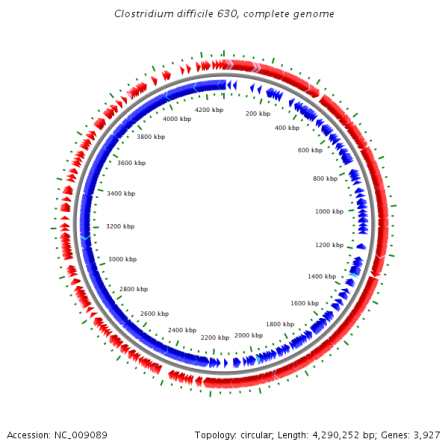General Characteristics of Clostridium difficile
Clostridium difficile is a species of Gram-positive, rod-shaped, spore-forming bacteria. C. difficile are anaerobic—lives in the absence of oxygen. In the presence of oxygen, the vegetative form of C. difficile can survive up to 24 hours on an inanimate surface; whereas, C. difficile spores can survive up to 2 years on inanimate surfaces that are exposed to oxygen.
 HABITAT—Where does Clostridium difficile
live?
HABITAT—Where does Clostridium difficile
live?
C. difficile inhabits the microflora of intestines of humans. Around 3% of healthy adults and up to 70% of babies have a number of C. difficile bacteria living in their gut. However, the number of C. difficile bacteria is kept very low and in control by the millions of harmless bacteria in the intestines that aid in digestion. Ideal condition for growth is around 37ºC (98.6 ºF); this explains why the human body plays the perfect host for C. difficile. (For more information on how the human plays the host for C. difficile, check out the Pathology page.)
GROWTH—How does Clostridium difficile grow and reproduce?
C. difficile reproduces by binary fission. As seen in the picture on the right, the circular strand of DNA begins replicating. Then, the cell begins elongating as the new copies of DNA start to move to opposite ends of the cell. Once replication is finished, the cell continues to grow, and the plasma membrane begins to invaginate until a new cell wall establishes. The result is two identical daughter cells with an exact copy of the original cell’s DNA.
From (public domain): Wikipedia 2009. <URL:
http://en.wikipedia.org/wiki/File:Binary_fission.png>.
Accessed 4 April 2009.
GENOME—What makes up the DNA of Clostridium
difficile?
C. difficile has one circular chromosome that has 4,290,252 base pairs and a circular plasmid with 7,881 base pairs. Conjunctive transposons make up about 11% of the genome. Transposons are movable DNA fragments that can move from one location to another within the genome. These transposons provide C. difficile with the ability to be incredibly virulent, resist some antibiotics, and cause extreme disease in its host.
Used with permission: Savita Shrivastava. 2007 BacMap
<URL: http://wishart.biology.ualberta.ca/BacMap/graphs_cgview.html>.
Accessed 7 April 2009.
MOVEMENT—How does Clostridium difficile
move?
C. difficile moves via peritrichous flagella. These flagella are evenly spread around the surface of each cell and allow the bacteria to be highly motile. The bacteria are able to move by a tumbling motion and by movement in a forward direction.
Used with permission from: Poxton, I. R. 2005. Clostridium difficile. Journal
of Medical Microbiology 54: 97-100.
NUTRITION- How does Clostridium difficile
get its food and energy?
C. difficile is heterotrophic which means that it cannot make its own food and relies on organic substances for nutrition. Since C. difficile is anaerobic, it obtains its energy, ATP, by fermentation of carbon and nitrogen substrates. C. difficile requires six amino acids for fermentative metabolism and growth—leucine, isoleucine, proline, tryptophan, valine, and glycine.
ADAPTATIONS--How does Clostridium difficile
survive harsh conditions and continue to cause disease?
C. difficile exists in two states—the vegetative (growth) state or the spore state. In the vegetative state, the bacterium is able to use nutrients to grow and divide. However, when conditions become unfavorable, C. difficile is able to enter a dormant state and form a highly resistant spore. Unfavorable conditions include a deprivation of nutrients, an exposure to a very acidic environment, or an exposure to high temperatures. These spores are very resistant to heat, radiation, drying, chemicals, and even oxygen (for up to two years). The spore is in a dormant state and its genetic material is protected by a thick spore coat. When conditions become favorable again, the C. difficile spore is able to return to its vegetative state. (Scroll to the bottom of the link to see an amazing photograph of C. difficile endospores) It’s also important to note that when the bacteria are faced with stress and unfavorable conditions, their ability to adhere to human intestinal cells is increased, making colonization easier. The bacteria’s ability to form spores enables its survival through the human digestive system and out into the oxygenated environment until it returns to its human host and back into the vegetative state.
Adapted from: Merkel. 2006. Microbe World. <URL:http://www.microbeworld.org/know/spore.aspx>. Accessed 7 April 2009.
Now that you have learned how C. difficile is able to grow,
survive, reproduce, and move,
you are ready to learn how C.
difficile causes disease.


